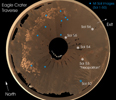This image shows an overhead view of the Mars Exploration RoverOpportunity landing site at Meridiani Planum, nicknamed "EagleCrater." Scientists are conducting a soil survey here to see how thesoils in this crater relate to the soils near the Meridiani Planum rockoutcrop, as well as on the plains outside the crater. Scientists havestudied the soils in great detail on the north and west sides of thecrater, and plan to study five more locations before Opportunity exits thecrater. As of sol 54 of Opportunity's journey (March 18, 2004), the rover isstationed at the sol 53 stop, located in the bottom right quadrant of thisimage. Scientists are examining light and dark soil targets at this spot,dubbed "Neopolitan" because it is a triple boundary between light soil,dark soil, and an airbag bounce mark.
This 3-D visualization was displayed using software developed by NASA'sAmes Research Center and images from Opportunity's panoramic camera,taken while the rover was still on the lander.

Figure 1Eagle Crater Traverse Map
Figure 1 shows an overhead view of the Mars Exploration RoverOpportunity landing site at Meridiani Planum, nicknamed "EagleCrater." Scientists are conducting a soil survey here to see how thesoils in this crater relate to the soils by the Meridiani Planum rockoutcrop, as well as on the plains outside the crater. They have studiedthe soils in great detail on the north and west sides of the crater.Locations within the crater where scientists have taken microscopicimages of the soil are shown in blue.

Figure 2Sampling "Eagle Crater"
Scientists have studied five unique target soil patches on the south and east sides of the crater using the microscopic imager and Moessbauer spectrometer. "Goal 5" is a wind-rippled spot on the upper part of the crater, which the miniature thermal emission spectrometer shows is high in hematite content compared to other soils in the crater. "Neopolitan" lies on a triple boundary of a light soil unit, a dark soil unit and an airbag bounce mark. "Mudpie" was chosen to represent typical soils on the lower part of the crater that are relatively far from the outcrop. "Meringue" is a unique rippled area near the lander that features patches of "whitish" material in between the ripples. "Black Forest" is another upper crater soil unit but is low in hematite content based on data from the miniature thermal emission spectrometer. It also differs in appearance from the lower crater soils based on panoramic and navigation camera images. Arrows point to the area where Opportunity first attempted to exit the crater and the alternate route it ultimately took to reach the plains.

 Planetary Data System
Planetary Data System














